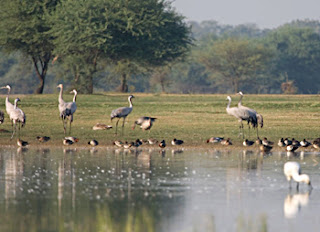Dasada Wild Ass Sanctuary, Dist. Surendranagar, Gujarat, India
Distance: - 95kms
How to get there: - take Sarkhej – Sanand road and drive up
to Zehnabad road
About the place: - the sanctuary is one of the last places on the earth where the endangered wild ass sub species Indian Wild ass Lives.
What to do there: -
Drive around along the open highway and you could spot
several herds of the endangered wild ass. They are excellent runners.
Blackbuck Sanctuary, Velavadar, Gujarat, India
How to get there: -Take Ahmadabad – Bhavnagar highway, turn
left from Pipli-Fedara link Road.
About the place: - the sanctuary is populated by blackbucks,
Blue Bull, antelope, wolves, jacket, Hyena, Wild Boars, jungle cat and a
variety of birds as well. It has saline lands, high tidal mudflats and prosopis
juliflora shrub land along with simple dense and sparse grasslands.
What to do there: - The roosting of harrier hawks at dusk is
an incredible sight. More than 1,500 can be seen gathering at a single site.
Meet the Kathi community members. Who like the Bishnoi community have protected
the blackbuck.
Nalsarovar Bird Sanctuary, Dist. Surendranagar, Gujarat, India
Distance: - 54 kms
How to get there: - Take Ahmadabad - Sanand Road and turn left from Sanand Crossroads.
About the place: - the sanctuary is a Ramsar site and mainly
comprises a huge lake of about 100 sq km and ambient marshes where you can see
flamingoes, pelicans, geese, cranes, storks, ibises, spoonbills, wading birds,
swallows, fishing eagles, osprey and harriers in great numbers during this
season.
What to do there: - You can hire country boasts on the lake
for bird viewing. For picnickers there are shacks on the islands. There are
also two water parks nearby where children can have fun.
Thol bird Sanctuary, Ahmadabad, Gujarat, India
How to get there: - Hop on the SP Ring Road, turn left from
Shilaj crossroads and head straight.
About the place: - the sanctuary is a shallow freshwater
body, surrounded by marshes on the edge and scrubby forest flanking its sides.
This place is home to more than 100 species of birds. Cranes, geese,
flamingoes, pelicans, egrets, herons, spoonbills, ducks, whistling teals and
many other migratory birds can be seen here.
What to do there: - while driving to the lake, keep a watch
for the variety of birds which populate the pools and canals on the way.
Polo – Vijaynagar Forests
Distance 148 kms
How to get there: - Take Himmatnagar Highway, enter Idar –
Ambaji road and turn right from Mathasur Tri-junction.
About the place: - the Ancient Polo city was built around
the river Harnav, an ancient water body spoken of in the Puranas.
What to do there: - It’s a picnickers’ paradise. The view
from the old palace and a royal tank is breathtaking. Remnants of Jain shrines
are know the world over.
Courtesy:- Times of India.
Courtesy:- Times of India.





